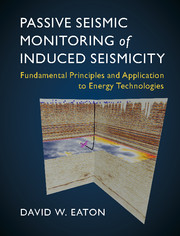 Passive Seismic Monitoring of Induced Seismicity
Passive Seismic Monitoring of Induced Seismicity Book contents
- Frontmatter
- Contents
- Preface
- List of Symbols
- Part I Fundamentals of Passive Seismic Monitoring
- Part II Applications of Passive Seismic Monitoring
- 5 Passive-Seismic Data Acquisition
- 6 Downhole Microseismic Processing
- 7 Surface and Shallow-Array Microseismic Processing
- 8 Microseismic Interpretation
- 9 Induced Seismicity
- Appendix A Glossary
- Appendix B Signal-Processing Essentials
- Appendix C Data Formats
- References
- Index
6 - Downhole Microseismic Processing
from Part II - Applications of Passive Seismic Monitoring
Published online by Cambridge University Press: 07 June 2018
- Frontmatter
- Contents
- Preface
- List of Symbols
- Part I Fundamentals of Passive Seismic Monitoring
- Part II Applications of Passive Seismic Monitoring
- 5 Passive-Seismic Data Acquisition
- 6 Downhole Microseismic Processing
- 7 Surface and Shallow-Array Microseismic Processing
- 8 Microseismic Interpretation
- 9 Induced Seismicity
- Appendix A Glossary
- Appendix B Signal-Processing Essentials
- Appendix C Data Formats
- References
- Index
Summary
We are what we repeatedly do. Excellence, then, is not an act, but a habit.
Aristotle, paraphrased by Durant (The Story of Philosophy, 1926)Downhole microseismic data are distinct from surface and near-surface recordings inasmuch as the sensors are generally installed in relatively close proximity to the treatment zone. This characteristic is both a help and a hindrance. The close proximity to the source region, coupled with the avoidance of highly attenuating near-surface layers, typically results in high-fidelity waveforms from events that might otherwise be undetectable; but, the constraints imposed by limited availability of deep, nearby wellbores means that the acquisition geometry is rarely close to ideal. In many cases, an expedient but sub-optimal configuration is employed with a single vertical observation well; it then becomes a matter of doing more with less.
Determining hypocentre locations using downhole microseismic data involves phase picking and quality control (QC) of P and S arrivals, estimation of hypocentral distance using the picked arrival times, and estimation of backazimuth based on waveform polarization. If more than one observation well is available, there are additional requirements for correlating observations between different wells (Warpinski et al., 2005a). While the need to pick P and S arrivals is shared by hypocentre location methods used for local or regional seismograph networks, there are important differences. For the most part, seismograph networks are deployed at the surface and sample a substantially greater aperture of the focal sphere. The techniques used for downhole microseismic are thus more akin to the seldom-used method of hypocentre location with a single seismograph station (Roberts et al., 1989; Farahbod et al., 2015b).
The goal of microseismic data processing is to transform continuous wavefield observations into precise and accurate estimates of event locations, magnitudes and other source characteristics. Figure 6.1 shows a simplified flow chart for the processing of downhole microseismic data after the monitoring program is complete. The basic processing sequence consists of two parallel workflows:
• a primary workflow, in which the waveform data are processed to produce an event catalogue;
• a secondary workflow that is used for estimation of sensor orientations, as well as construction and validation of a calibrated background model.
- Type
- Chapter
- Information
- Passive Seismic Monitoring of Induced SeismicityFundamental Principles and Application to Energy Technologies, pp. 158 - 189Publisher: Cambridge University PressPrint publication year: 2018
